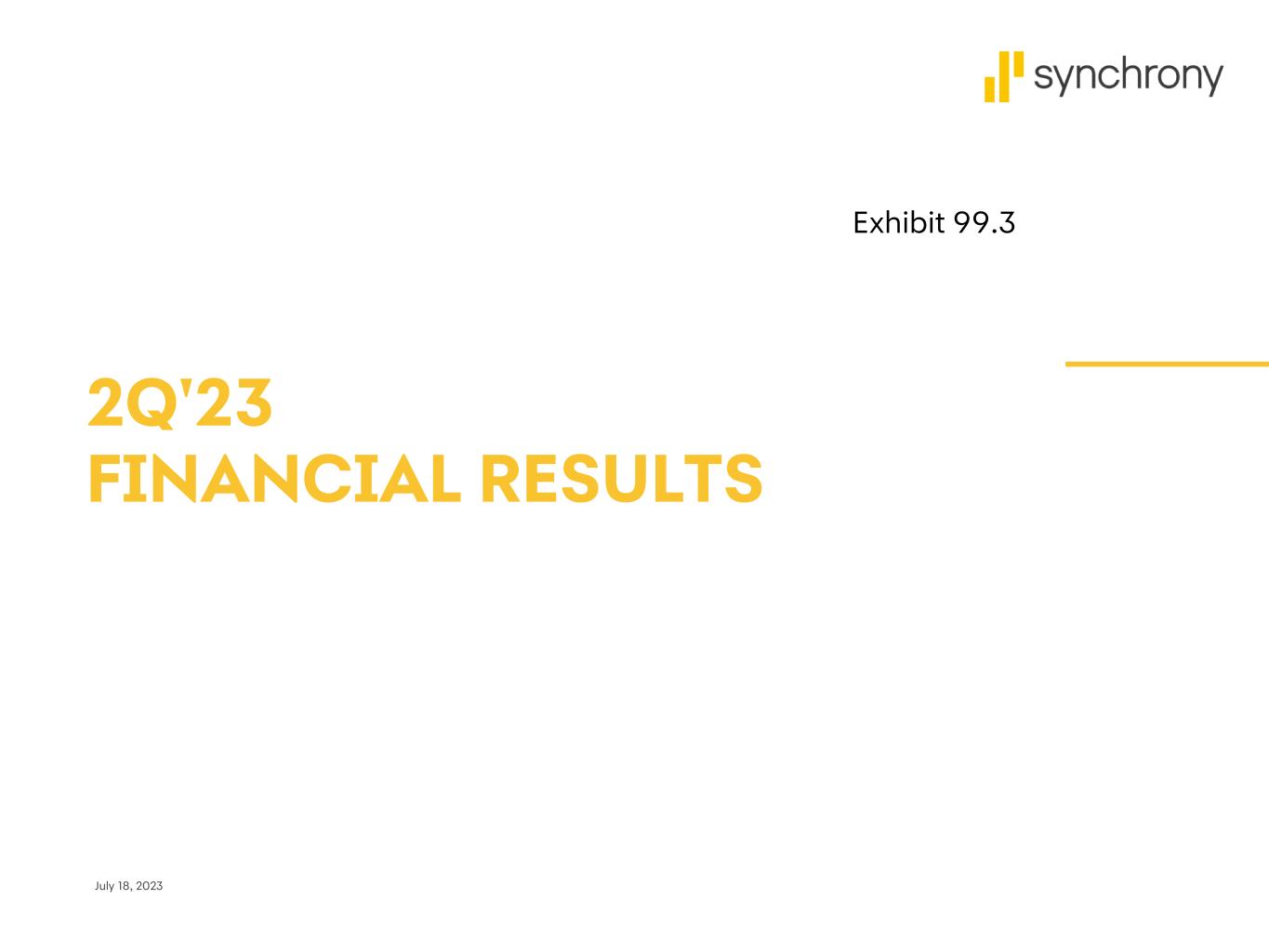
2Q'23 FINANCIAL RESULTS July 18, 2023 Exhibit 99.3
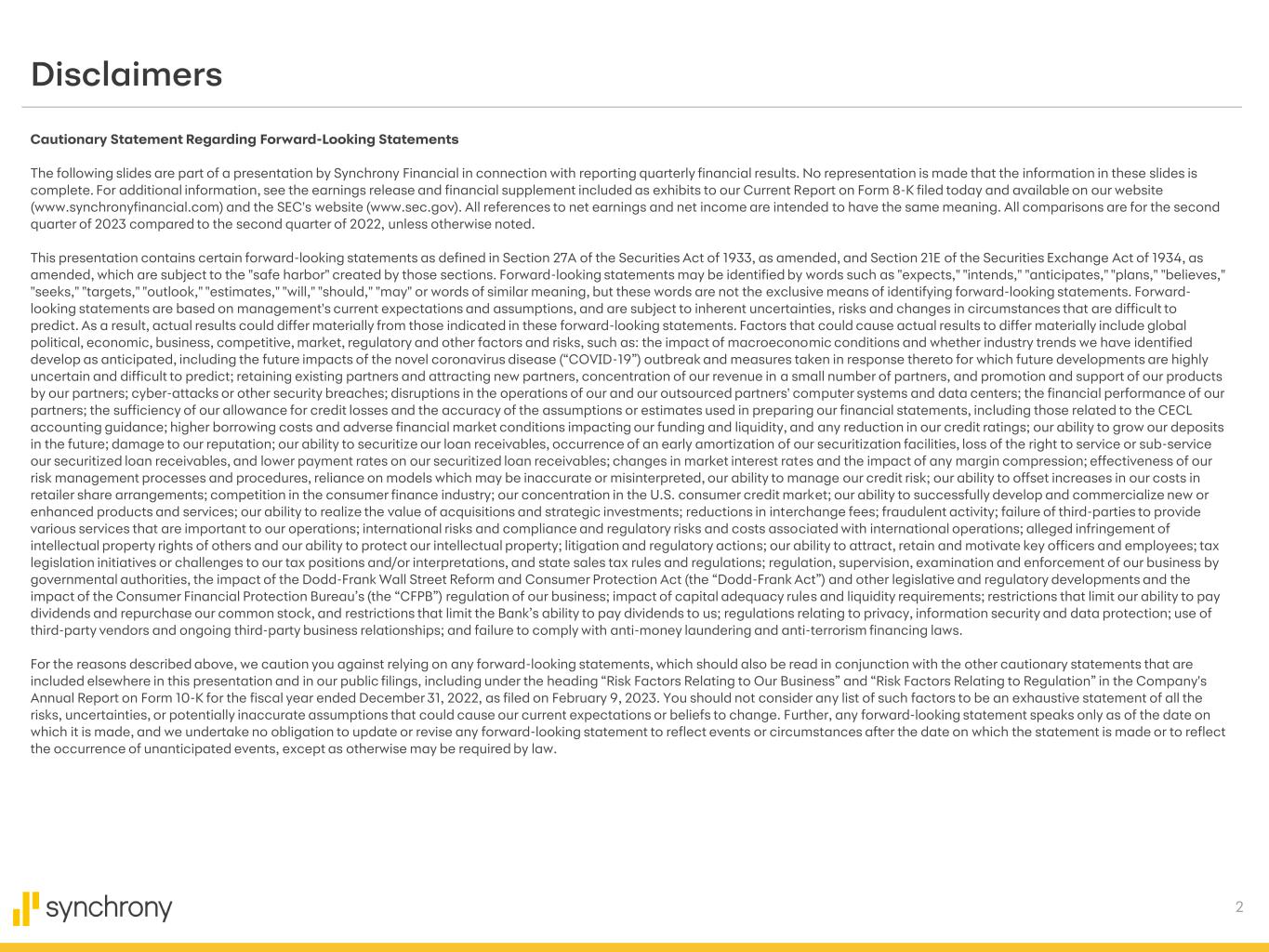
2 Cautionary Statement Regarding Forward-Looking Statements The following slides are part of a presentation by Synchrony Financial in connection with reporting quarterly financial results. No representation is made that the information in these slides is complete. For additional information, see the earnings release and financial supplement included as exhibits to our Current Report on Form 8-K filed today and available on our website (www.synchronyfinancial.com) and the SEC's website (www.sec.gov). All references to net earnings and net income are intended to have the same meaning. All comparisons are for the second quarter of 2023 compared to the second quarter of 2022, unless otherwise noted. This presentation contains certain forward-looking statements as defined in Section 27A of the Securities Act of 1933, as amended, and Section 21E of the Securities Exchange Act of 1934, as amended, which are subject to the "safe harbor" created by those sections. Forward-looking statements may be identified by words such as "expects," "intends," "anticipates," "plans," "believes," "seeks," "targets," "outlook," "estimates," "will," "should," "may" or words of similar meaning, but these words are not the exclusive means of identifying forward-looking statements. Forward- looking statements are based on management's current expectations and assumptions, and are subject to inherent uncertainties, risks and changes in circumstances that are difficult to predict. As a result, actual results could differ materially from those indicated in these forward-looking statements. Factors that could cause actual results to differ materially include global political, economic, business, competitive, market, regulatory and other factors and risks, such as: the impact of macroeconomic conditions and whether industry trends we have identified develop as anticipated, including the future impacts of the novel coronavirus disease (“COVID-19”) outbreak and measures taken in response thereto for which future developments are highly uncertain and difficult to predict; retaining existing partners and attracting new partners, concentration of our revenue in a small number of partners, and promotion and support of our products by our partners; cyber-attacks or other security breaches; disruptions in the operations of our and our outsourced partners' computer systems and data centers; the financial performance of our partners; the sufficiency of our allowance for credit losses and the accuracy of the assumptions or estimates used in preparing our financial statements, including those related to the CECL accounting guidance; higher borrowing costs and adverse financial market conditions impacting our funding and liquidity, and any reduction in our credit ratings; our ability to grow our deposits in the future; damage to our reputation; our ability to securitize our loan receivables, occurrence of an early amortization of our securitization facilities, loss of the right to service or sub-service our securitized loan receivables, and lower payment rates on our securitized loan receivables; changes in market interest rates and the impact of any margin compression; effectiveness of our risk management processes and procedures, reliance on models which may be inaccurate or misinterpreted, our ability to manage our credit risk; our ability to offset increases in our costs in retailer share arrangements; competition in the consumer finance industry; our concentration in the U.S. consumer credit market; our ability to successfully develop and commercialize new or enhanced products and services; our ability to realize the value of acquisitions and strategic investments; reductions in interchange fees; fraudulent activity; failure of third-parties to provide various services that are important to our operations; international risks and compliance and regulatory risks and costs associated with international operations; alleged infringement of intellectual property rights of others and our ability to protect our intellectual property; litigation and regulatory actions; our ability to attract, retain and motivate key officers and employees; tax legislation initiatives or challenges to our tax positions and/or interpretations, and state sales tax rules and regulations; regulation, supervision, examination and enforcement of our business by governmental authorities, the impact of the Dodd-Frank Wall Street Reform and Consumer Protection Act (the “Dodd-Frank Act”) and other legislative and regulatory developments and the impact of the Consumer Financial Protection Bureau’s (the “CFPB”) regulation of our business; impact of capital adequacy rules and liquidity requirements; restrictions that limit our ability to pay dividends and repurchase our common stock, and restrictions that limit the Bank’s ability to pay dividends to us; regulations relating to privacy, information security and data protection; use of third-party vendors and ongoing third-party business relationships; and failure to comply with anti-money laundering and anti-terrorism financing laws. For the reasons described above, we caution you against relying on any forward-looking statements, which should also be read in conjunction with the other cautionary statements that are included elsewhere in this presentation and in our public filings, including under the heading “Risk Factors Relating to Our Business” and “Risk Factors Relating to Regulation” in the Company's Annual Report on Form 10-K for the fiscal year ended December 31, 2022, as filed on February 9, 2023. You should not consider any list of such factors to be an exhaustive statement of all the risks, uncertainties, or potentially inaccurate assumptions that could cause our current expectations or beliefs to change. Further, any forward-looking statement speaks only as of the date on which it is made, and we undertake no obligation to update or revise any forward-looking statement to reflect events or circumstances after the date on which the statement is made or to reflect the occurrence of unanticipated events, except as otherwise may be required by law. Disclaimers
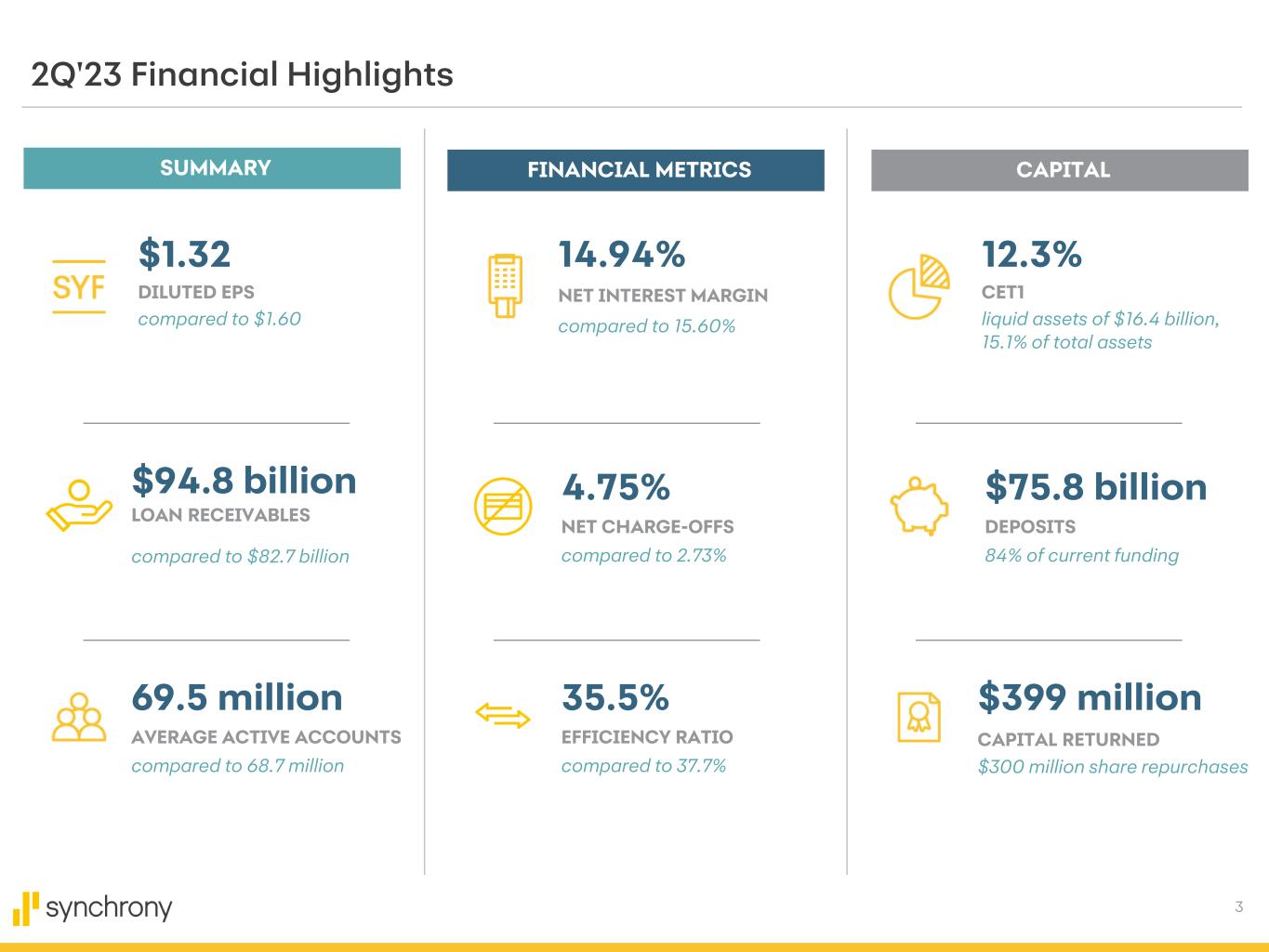
3 $1.32 DILUTED EPS compared to $1.60 14.94% NET INTEREST MARGIN compared to 15.60% 12.3% CET1 liquid assets of $16.4 billion, 15.1% of total assets SUMMARY FINANCIAL METRICS CAPITAL 2Q'23 Financial Highlights $94.8 billion LOAN RECEIVABLES compared to $82.7 billion $75.8 billion DEPOSITS 84% of current funding 4.75% NET CHARGE-OFFS compared to 2.73% 69.5 million AVERAGE ACTIVE ACCOUNTS compared to 68.7 million $399 million CAPITAL RETURNED $300 million share repurchases 35.5% EFFICIENCY RATIO compared to 37.7%
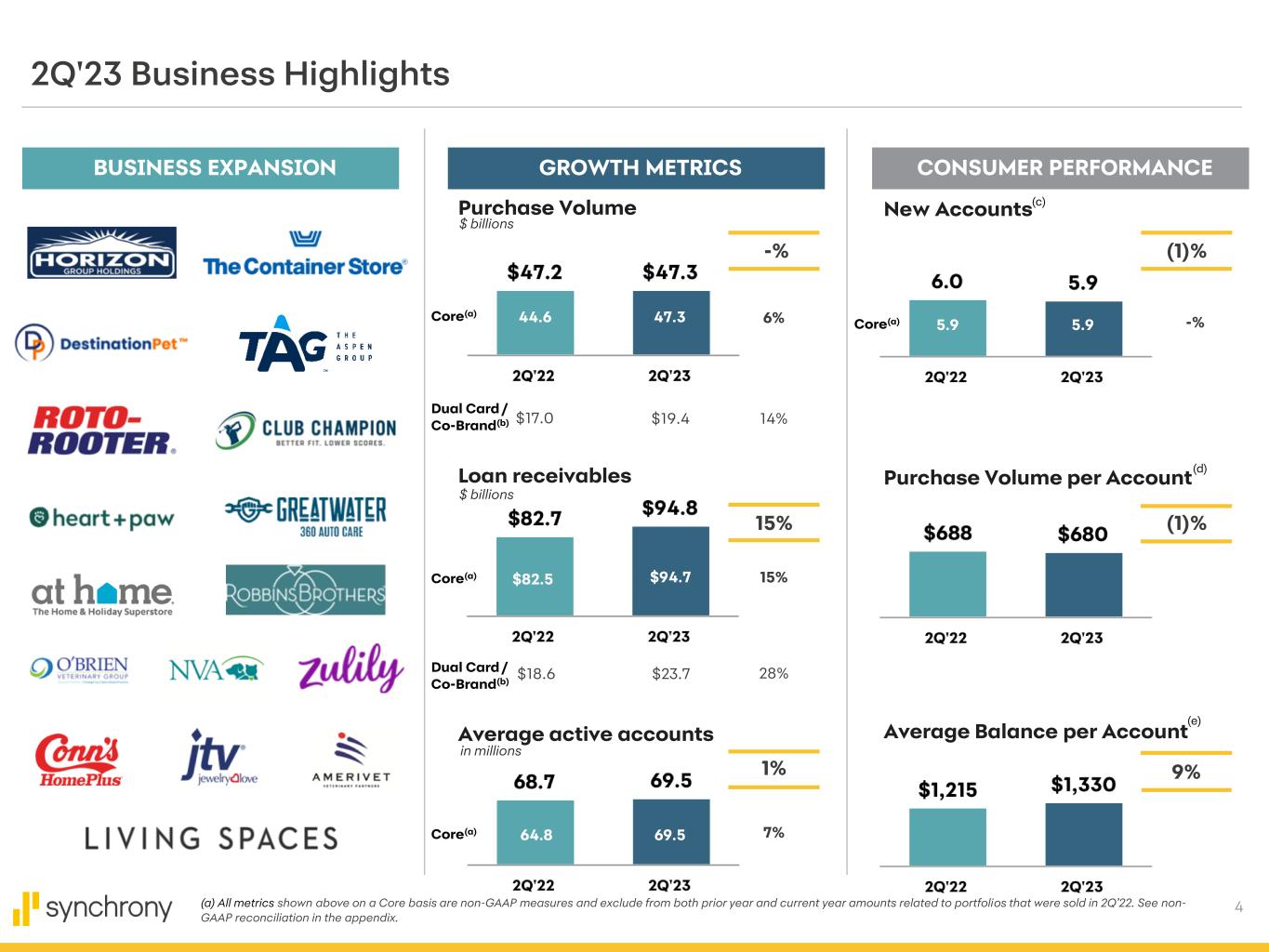
4 9% Average Balance per Account Dual Card / Co-Brand(b) BUSINESS EXPANSION CONSUMER PERFORMANCE (1)% (1)% New Accounts Purchase Volume per Account (c) (d) (e) GROWTH METRICS -% 15% 1% Purchase Volume Average active accounts 15% Loan receivables $82.5 $94.7Core(a) in millions $18.6 Dual Card / Co-Brand(b) $17.0 14%$19.4 $ billions $23.7 $ billions 2Q'23 Business Highlights 6% 7% Core(a) 44.6 47.3 Core(a) 69.5 5.95.9Core(a) -% 28% 64.8 (a) All metrics shown above on a Core basis are non-GAAP measures and exclude from both prior year and current year amounts related to portfolios that were sold in 2Q’22. See non- GAAP reconciliation in the appendix.
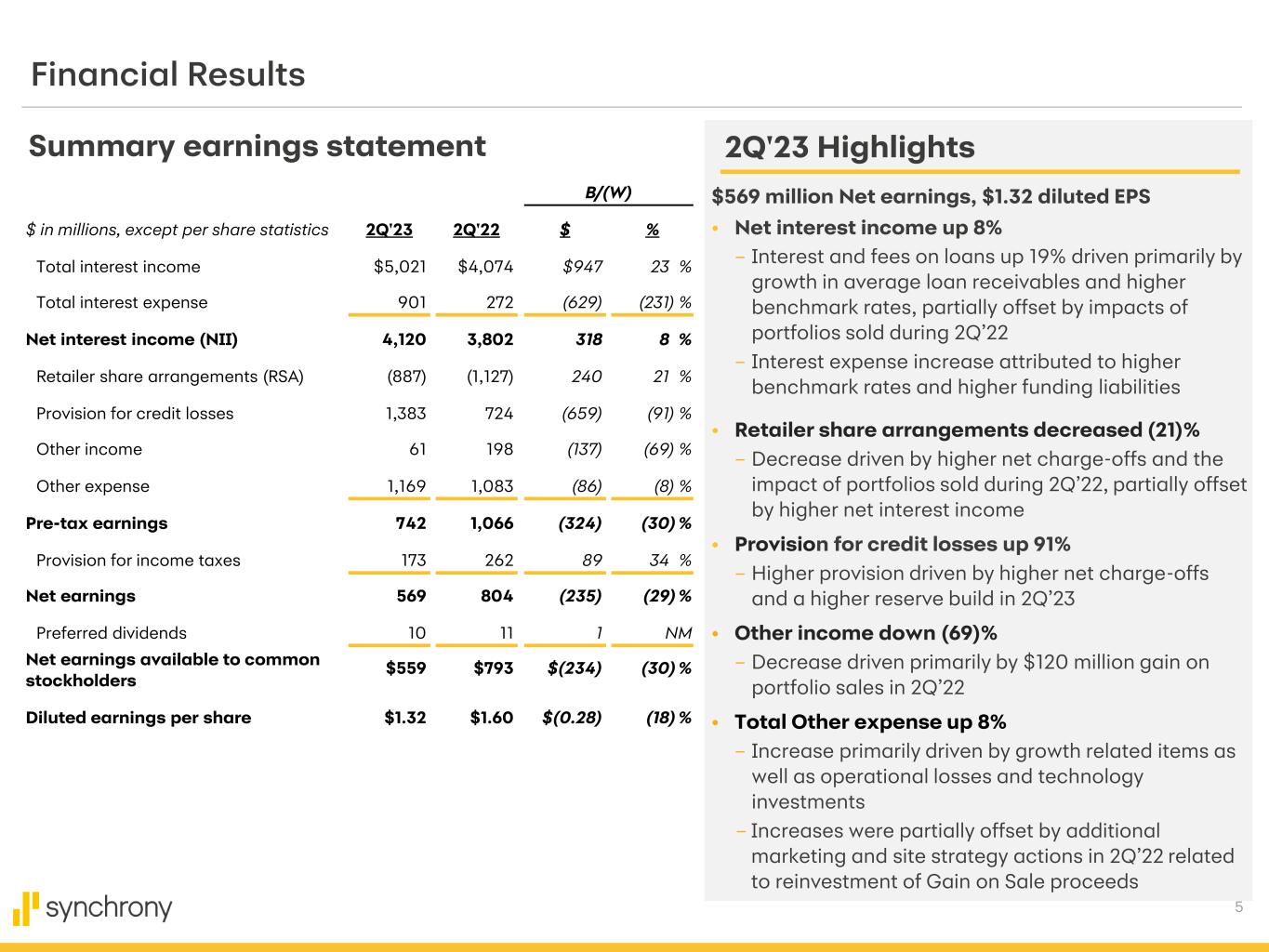
5 $569 million Net earnings, $1.32 diluted EPS • Net interest income up 8% – Interest and fees on loans up 19% driven primarily by growth in average loan receivables and higher benchmark rates, partially offset by impacts of portfolios sold during 2Q’22 – Interest expense increase attributed to higher benchmark rates and higher funding liabilities • Retailer share arrangements decreased (21)% – Decrease driven by higher net charge-offs and the impact of portfolios sold during 2Q’22, partially offset by higher net interest income • Provision for credit losses up 91% – Higher provision driven by higher net charge-offs and a higher reserve build in 2Q’23 • Other income down (69)% – Decrease driven primarily by $120 million gain on portfolio sales in 2Q’22 • Total Other expense up 8% – Increase primarily driven by growth related items as well as operational losses and technology investments – Increases were partially offset by additional marketing and site strategy actions in 2Q’22 related to reinvestment of Gain on Sale proceeds 2Q'23 Highlights B/(W) $ in millions, except per share statistics 2Q'23 2Q'22 $ % Total interest income $5,021 $4,074 $947 23 % Total interest expense 901 272 (629) (231) % Net interest income (NII) 4,120 3,802 318 8 % Retailer share arrangements (RSA) (887) (1,127) 240 21 % Provision for credit losses 1,383 724 (659) (91) % Other income 61 198 (137) (69) % Other expense 1,169 1,083 (86) (8) % Pre-tax earnings 742 1,066 (324) (30) % Provision for income taxes 173 262 89 34 % Net earnings 569 804 (235) (29) % Preferred dividends 10 11 1 NM Net earnings available to common stockholders $559 $793 $(234) (30) % Diluted earnings per share $1.32 $1.60 $(0.28) (18) % Summary earnings statement Financial Results
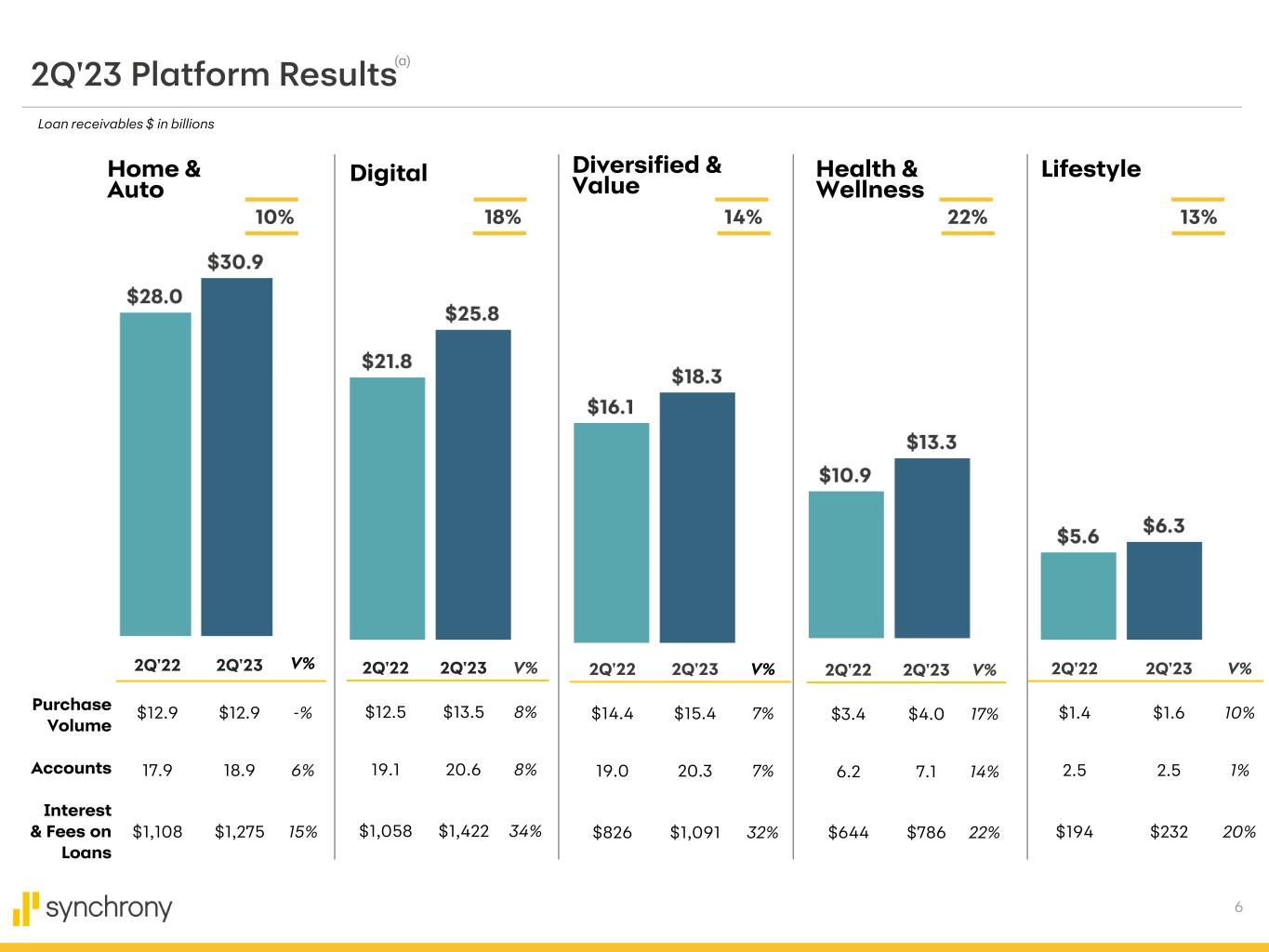
6 2Q'23 Platform Results 2Q'22 2Q'23 V% $12.9 $12.9 -% 17.9 18.9 6% $1,108 $1,275 15% 2Q'22 2Q'23 V% $12.5 $13.5 8% 19.1 20.6 8% $1,058 $1,422 34% 2Q'22 2Q'23 V% $14.4 $15.4 7% 19.0 20.3 7% $826 $1,091 32% 2Q'22 2Q'23 V% $3.4 $4.0 17% 6.2 7.1 14% $644 $786 22% 2Q'22 2Q'23 V% $1.4 $1.6 10% 2.5 2.5 1% $194 $232 20% Loan receivables $ in billions (a) Purchase Volume Accounts Interest & Fees on Loans Home & Auto Digital Diversified & Value Health & Wellness Lifestyle 10% 14% 22% 13%18%
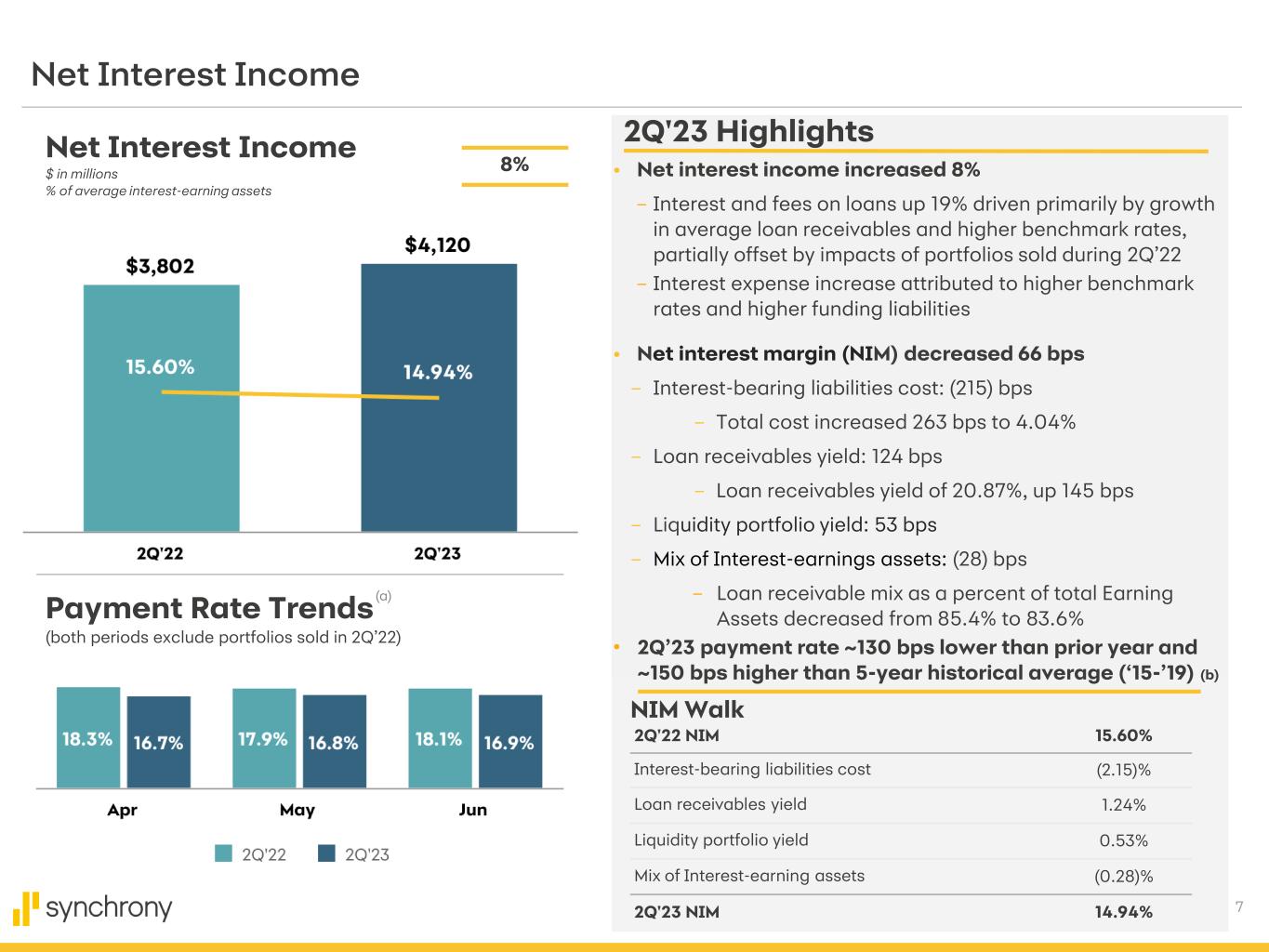
7 Net Interest Income Net Interest Income $ in millions % of average interest-earning assets NIM Walk Payment Rate Trends (both periods exclude portfolios sold in 2Q’22) (a) 8% • Net interest income increased 8% – Interest and fees on loans up 19% driven primarily by growth in average loan receivables and higher benchmark rates, partially offset by impacts of portfolios sold during 2Q’22 – Interest expense increase attributed to higher benchmark rates and higher funding liabilities • Net interest margin (NIM) decreased 66 bps – Interest-bearing liabilities cost: (215) bps – Total cost increased 263 bps to 4.04% – Loan receivables yield: 124 bps – Loan receivables yield of 20.87%, up 145 bps – Liquidity portfolio yield: 53 bps – Mix of Interest-earnings assets: (28) bps – Loan receivable mix as a percent of total Earning Assets decreased from 85.4% to 83.6% • 2Q’23 payment rate ~130 bps lower than prior year and ~150 bps higher than 5-year historical average (‘15-’19) (b) 2Q'22 NIM 15.60% Interest-bearing liabilities cost (2.15)% Loan receivables yield 1.24% Liquidity portfolio yield 0.53% Mix of Interest-earning assets (0.28)% 2Q'23 NIM 14.94% 2Q'23 Highlights
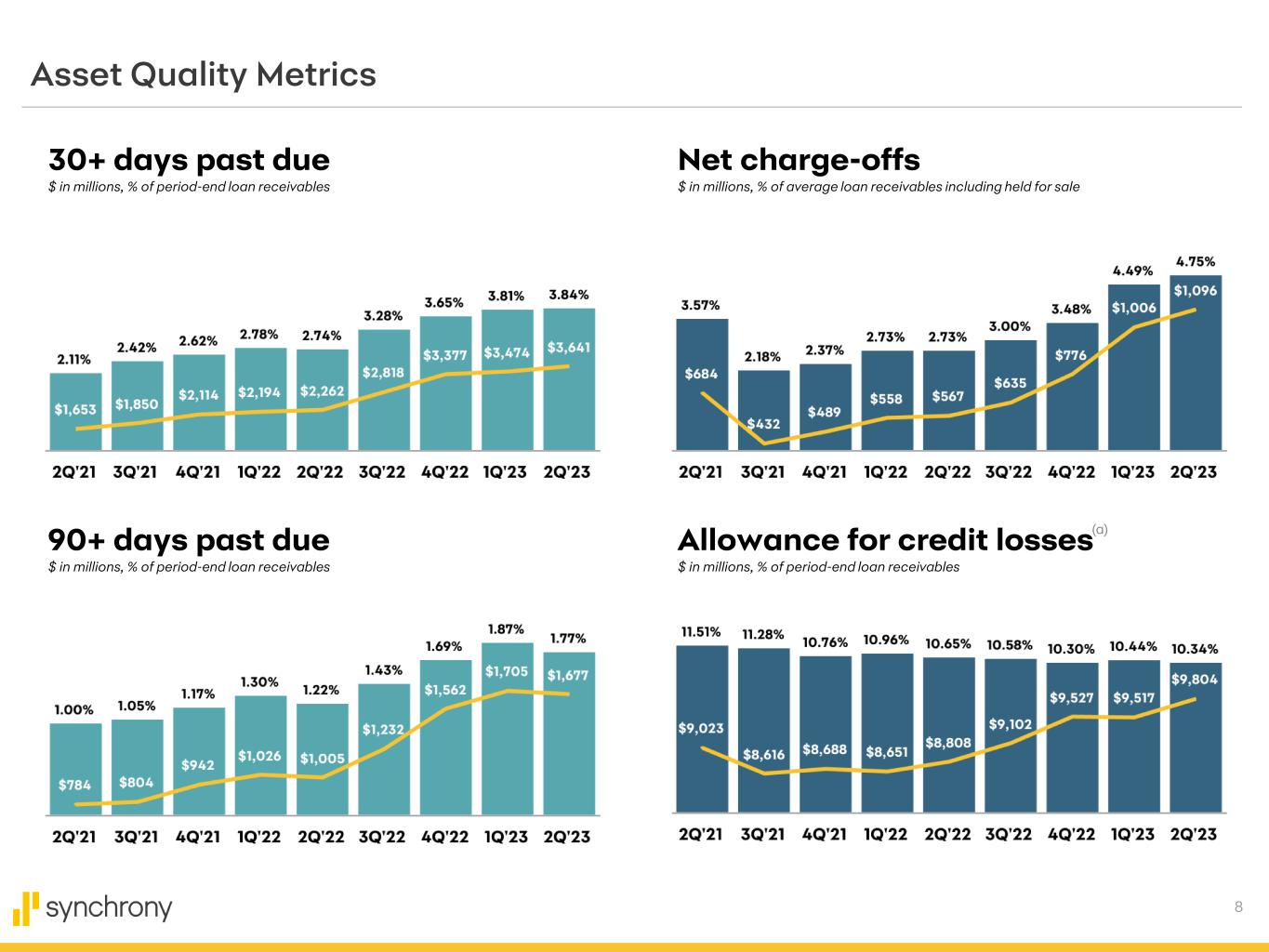
8 Asset Quality Metrics Allowance for credit losses $ in millions, % of period-end loan receivables Net charge-offs $ in millions, % of average loan receivables including held for sale 30+ days past due $ in millions, % of period-end loan receivables 90+ days past due $ in millions, % of period-end loan receivables (a)
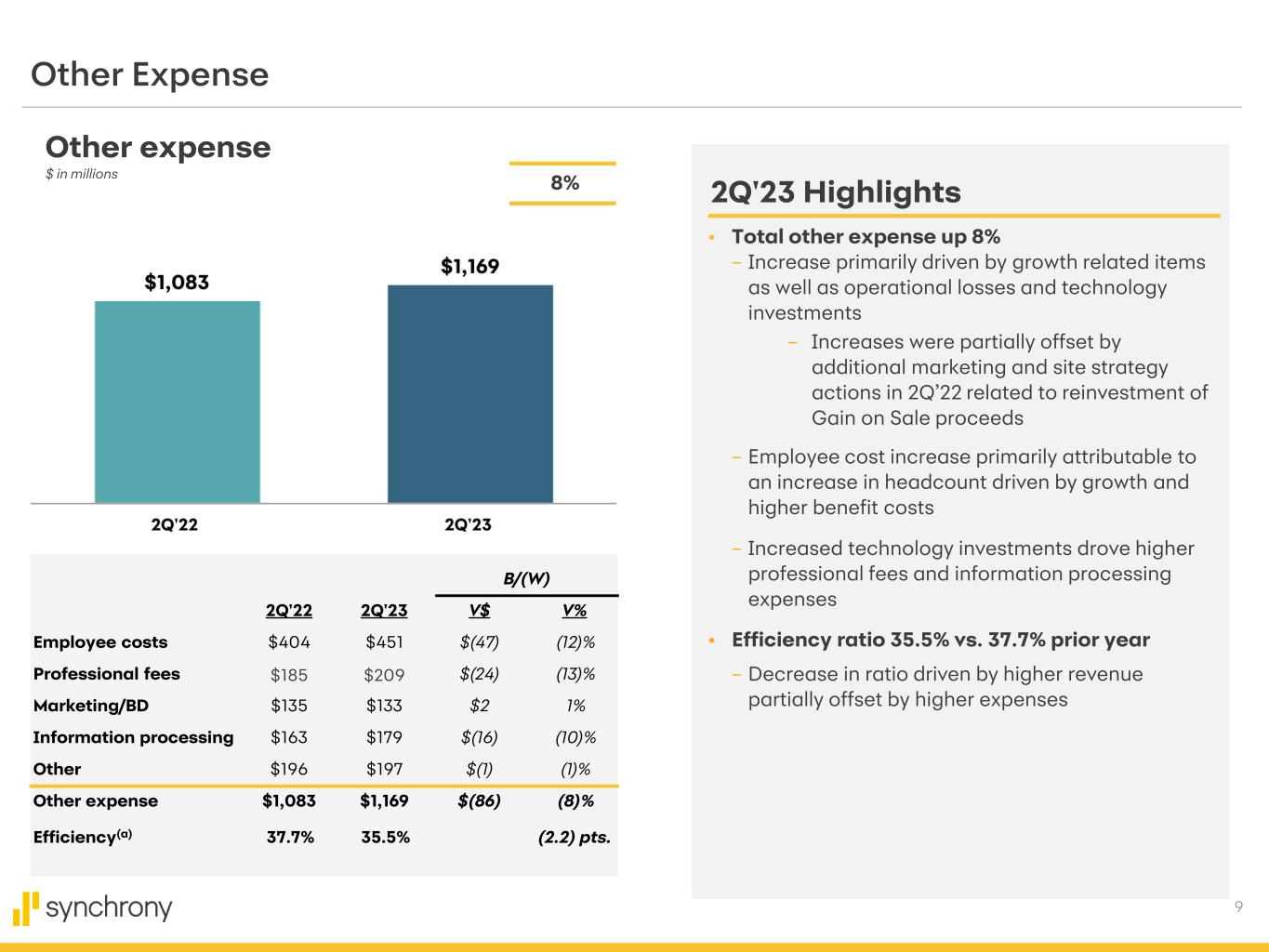
9 • Total other expense up 8% – Increase primarily driven by growth related items as well as operational losses and technology investments – Increases were partially offset by additional marketing and site strategy actions in 2Q’22 related to reinvestment of Gain on Sale proceeds – Employee cost increase primarily attributable to an increase in headcount driven by growth and higher benefit costs – Increased technology investments drove higher professional fees and information processing expenses • Efficiency ratio 35.5% vs. 37.7% prior year – Decrease in ratio driven by higher revenue partially offset by higher expenses B/(W) 2Q'22 2Q'23 V$ V% Employee costs $404 $451 $(47) (12)% Professional fees $185 $209 $(24) (13)% Marketing/BD $135 $133 $2 1% Information processing $163 $179 $(16) (10)% Other $196 $197 $(1) (1)% Other expense $1,083 $1,169 $(86) (8)% Efficiency(a) 37.7% 35.5% (2.2) pts. Other Expense Other expense $ in millions 2Q'23 Highlights8%
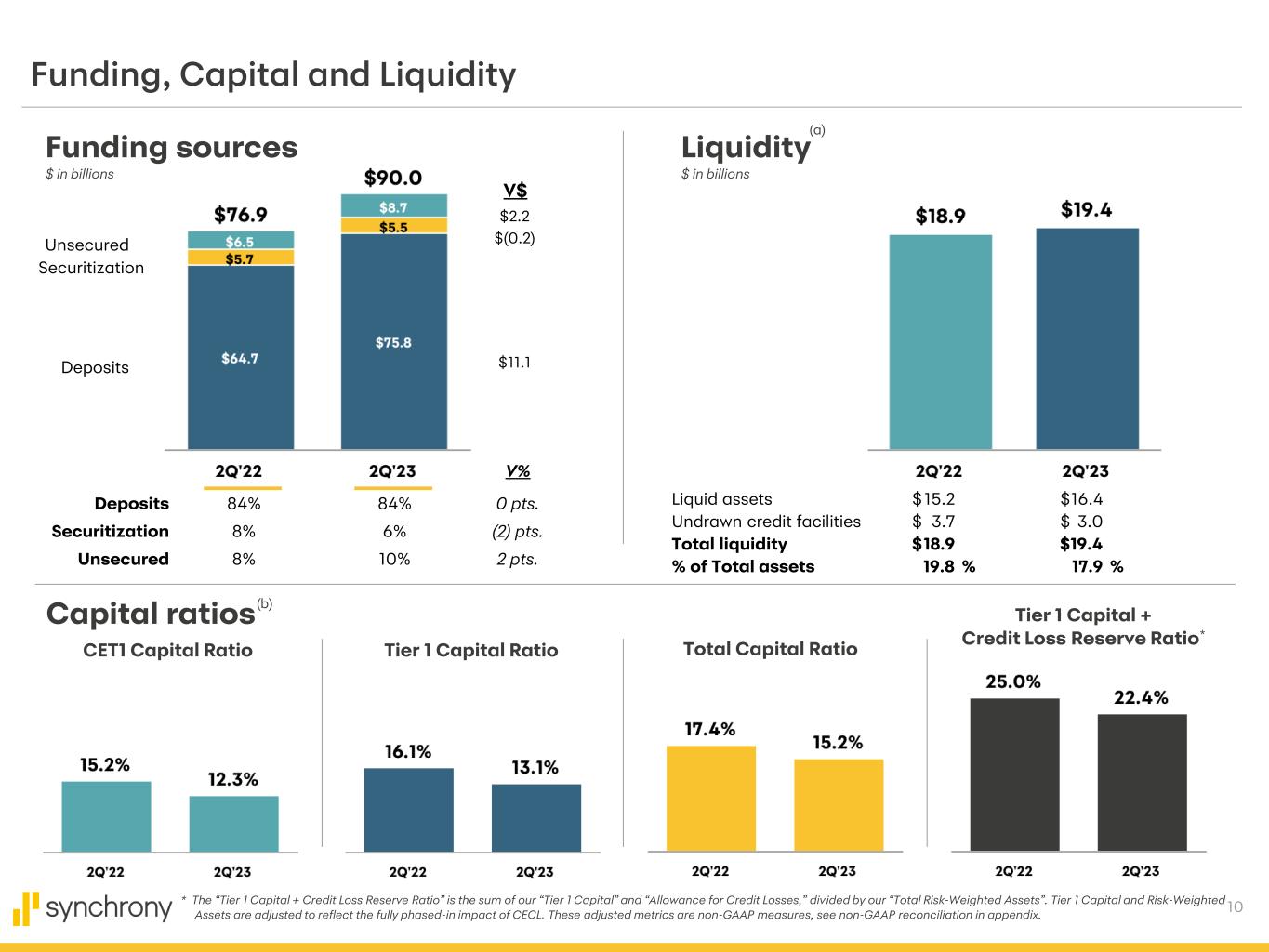
10 Tier 1 Capital + Credit Loss Reserve Ratio* Capital ratios Funding, Capital and Liquidity Funding sources $ in billions V$ $2.2 $(0.2) $11.1 V% Liquidity $ in billions CET1 Capital Ratio Tier 1 Capital Ratio Total Capital Ratio * The “Tier 1 Capital + Credit Loss Reserve Ratio” is the sum of our “Tier 1 Capital” and “Allowance for Credit Losses,” divided by our “Total Risk-Weighted Assets”. Tier 1 Capital and Risk-Weighted Assets are adjusted to reflect the fully phased-in impact of CECL. These adjusted metrics are non-GAAP measures, see non-GAAP reconciliation in appendix. Unsecured Securitization Deposits Deposits 84% 84% 0 pts. Securitization 8% 6% (2) pts. Unsecured 8% 10% 2 pts. Liquid assets $15.2 $16.4 Undrawn credit facilities $ 3.7 $ 3.0 Total liquidity $18.9 $19.4 % of Total assets 19.8 % 17.9 % (a) (b)
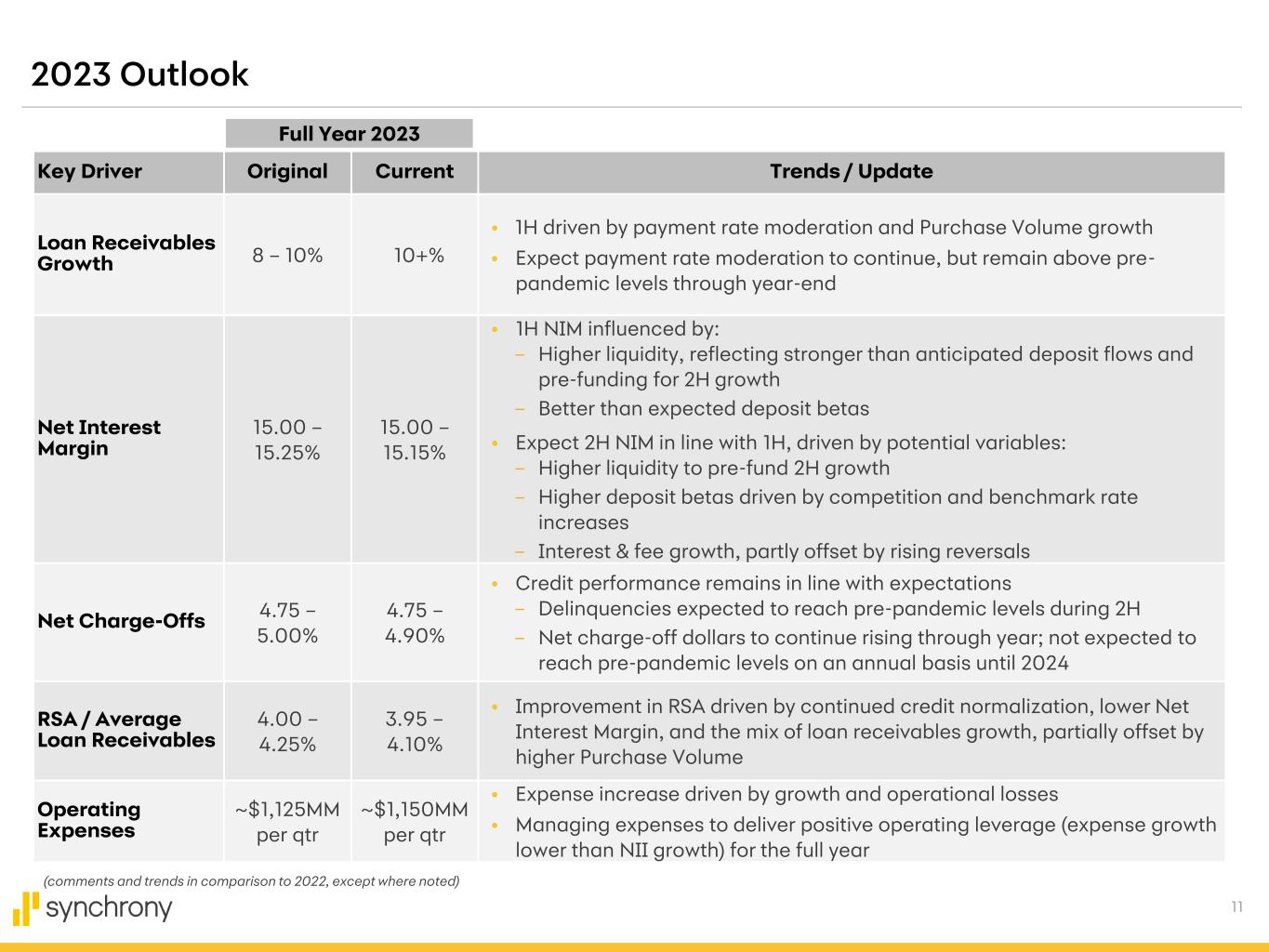
11 2023 Outlook Key Driver Original Current Trends / Update Loan Receivables Growth 8 – 10% 10+% • 1H driven by payment rate moderation and Purchase Volume growth • Expect payment rate moderation to continue, but remain above pre- pandemic levels through year-end Net Interest Margin 15.00 – 15.25% 15.00 – 15.15% • 1H NIM influenced by: – Higher liquidity, reflecting stronger than anticipated deposit flows and pre-funding for 2H growth – Better than expected deposit betas • Expect 2H NIM in line with 1H, driven by potential variables: – Higher liquidity to pre-fund 2H growth – Higher deposit betas driven by competition and benchmark rate increases – Interest & fee growth, partly offset by rising reversals Net Charge-Offs 4.75 – 5.00% 4.75 – 4.90% • Credit performance remains in line with expectations – Delinquencies expected to reach pre-pandemic levels during 2H – Net charge-off dollars to continue rising through year; not expected to reach pre-pandemic levels on an annual basis until 2024 RSA / Average Loan Receivables 4.00 – 4.25% 3.95 – 4.10% • Improvement in RSA driven by continued credit normalization, lower Net Interest Margin, and the mix of loan receivables growth, partially offset by higher Purchase Volume Operating Expenses ~$1,125MM per qtr ~$1,150MM per qtr • Expense increase driven by growth and operational losses • Managing expenses to deliver positive operating leverage (expense growth lower than NII growth) for the full year (comments and trends in comparison to 2022, except where noted) Full Year 2023
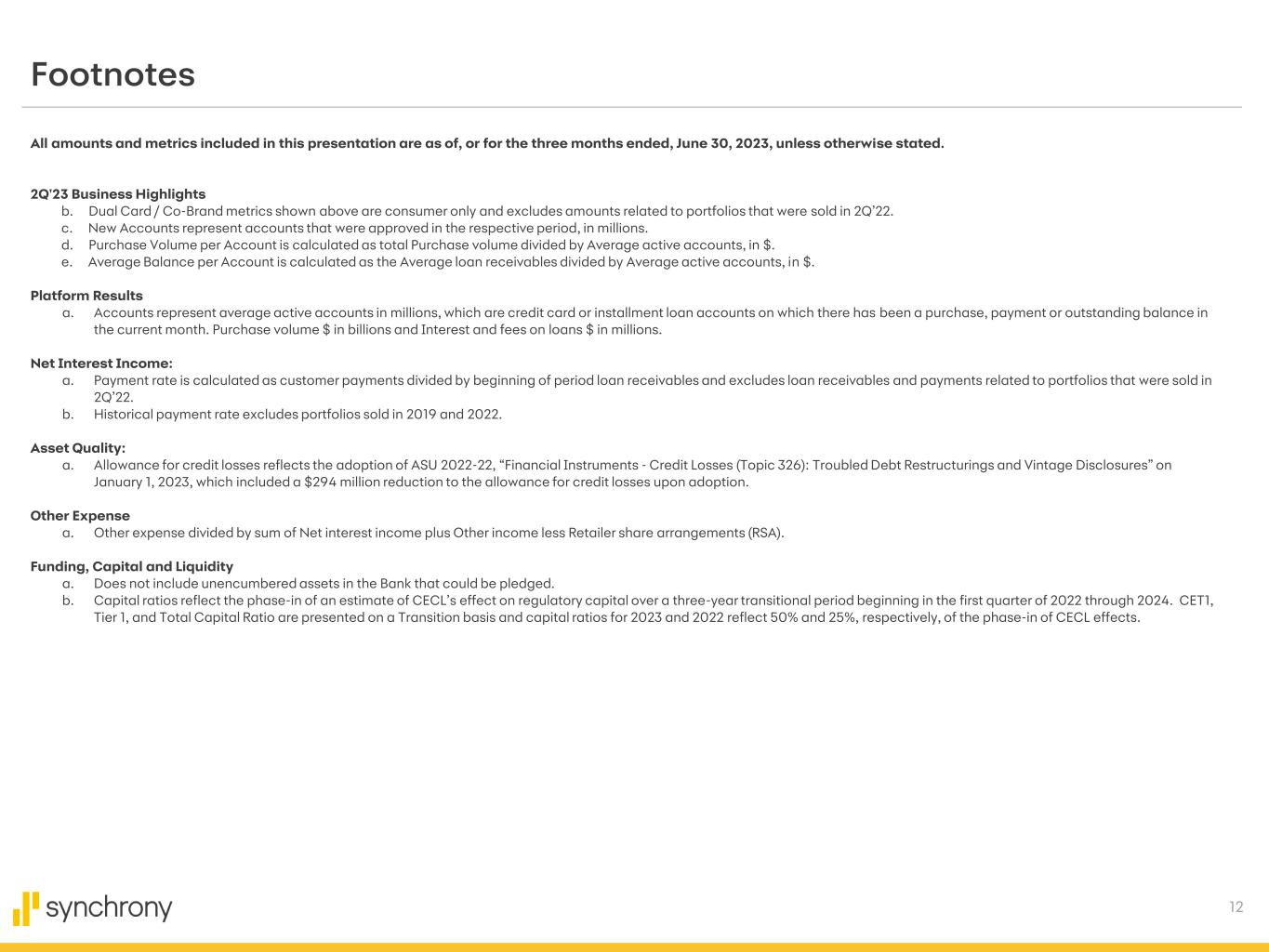
12 Footnotes All amounts and metrics included in this presentation are as of, or for the three months ended, June 30, 2023, unless otherwise stated. 2Q'23 Business Highlights b. Dual Card / Co-Brand metrics shown above are consumer only and excludes amounts related to portfolios that were sold in 2Q’22. c. New Accounts represent accounts that were approved in the respective period, in millions. d. Purchase Volume per Account is calculated as total Purchase volume divided by Average active accounts, in $. e. Average Balance per Account is calculated as the Average loan receivables divided by Average active accounts, in $. Platform Results a. Accounts represent average active accounts in millions, which are credit card or installment loan accounts on which there has been a purchase, payment or outstanding balance in the current month. Purchase volume $ in billions and Interest and fees on loans $ in millions. Net Interest Income: a. Payment rate is calculated as customer payments divided by beginning of period loan receivables and excludes loan receivables and payments related to portfolios that were sold in 2Q’22. b. Historical payment rate excludes portfolios sold in 2019 and 2022. Asset Quality: a. Allowance for credit losses reflects the adoption of ASU 2022-22, “Financial Instruments - Credit Losses (Topic 326): Troubled Debt Restructurings and Vintage Disclosures” on January 1, 2023, which included a $294 million reduction to the allowance for credit losses upon adoption. Other Expense a. Other expense divided by sum of Net interest income plus Other income less Retailer share arrangements (RSA). Funding, Capital and Liquidity a. Does not include unencumbered assets in the Bank that could be pledged. b. Capital ratios reflect the phase-in of an estimate of CECL’s effect on regulatory capital over a three-year transitional period beginning in the first quarter of 2022 through 2024. CET1, Tier 1, and Total Capital Ratio are presented on a Transition basis and capital ratios for 2023 and 2022 reflect 50% and 25%, respectively, of the phase-in of CECL effects.


14 Non-GAAP Reconciliation The following table sets forth the components of our Core key metrics for the periods indicated below. $ and accounts in millions Quarter Ended June 30 Total 2022 2023 Loan receivables $ 82,674 $ 94,801 Less: Gap and BP Loan receivables (174) (67) Core Loan receivables $ 82,500 $ 94,734 Purchase volume $ 47,217 $ 47,276 Less: Gap and BP Purchase volume (2,597) — Core Purchase volume $ 44,620 $ 47,276 Average active accounts 68.7 69.5 Less: Gap and BP Average active accounts (3.9) — Core Average active accounts 64.8 69.5 New Accounts 6.0 5.9 Less: Gap and BP New Accounts (0.1) — Core New Accounts 5.9 5.9
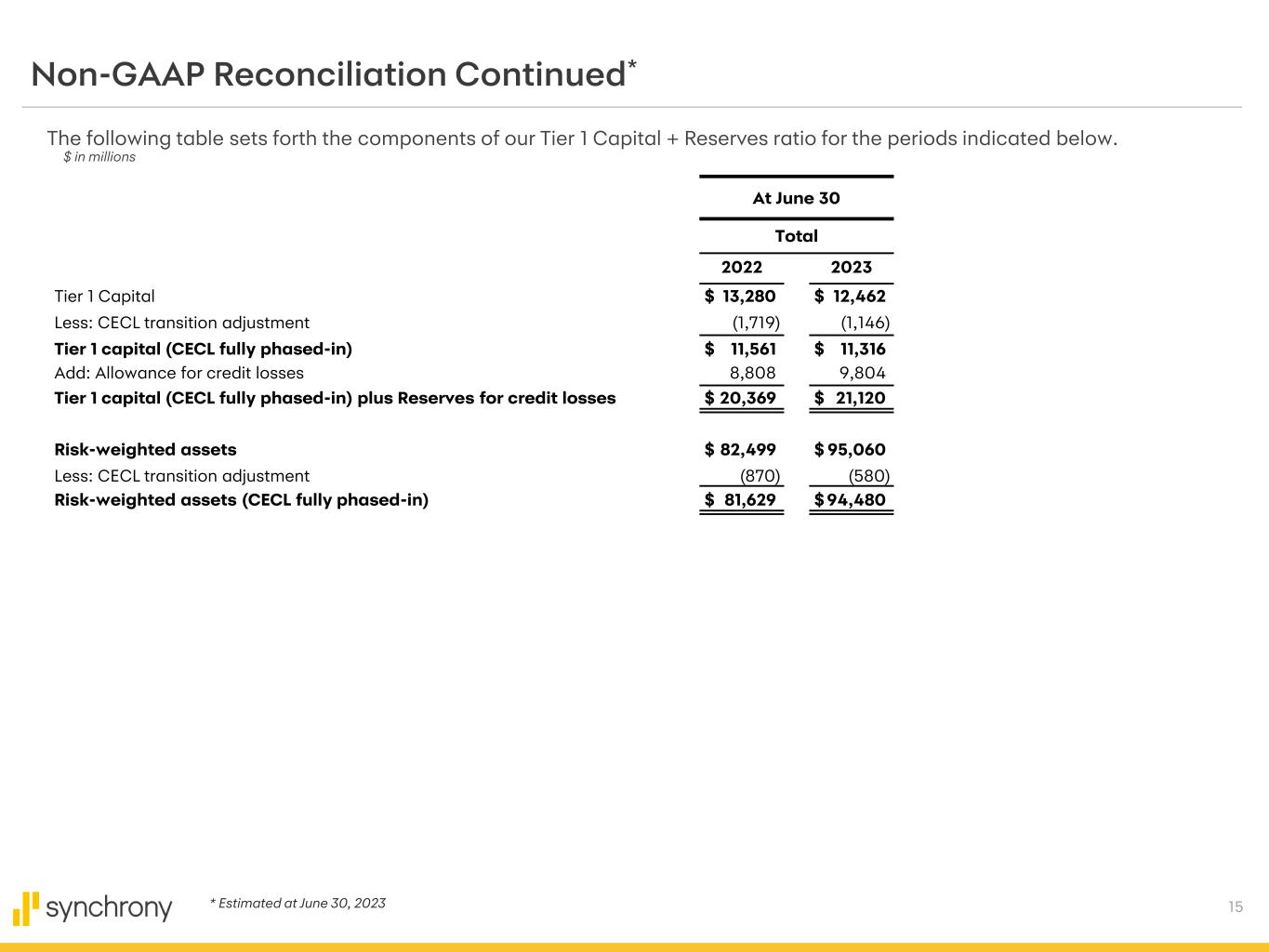
15 Non-GAAP Reconciliation Continued* The following table sets forth the components of our Tier 1 Capital + Reserves ratio for the periods indicated below. $ in millions At June 30 Total 2022 2023 Tier 1 Capital $ 13,280 $ 12,462 Less: CECL transition adjustment (1,719) (1,146) Tier 1 capital (CECL fully phased-in) $ 11,561 $ 11,316 Add: Allowance for credit losses 8,808 9,804 Tier 1 capital (CECL fully phased-in) plus Reserves for credit losses $ 20,369 $ 21,120 Risk-weighted assets $ 82,499 $ 95,060 Less: CECL transition adjustment (870) (580) Risk-weighted assets (CECL fully phased-in) $ 81,629 $ 94,480 * Estimated at June 30, 2023